Key points
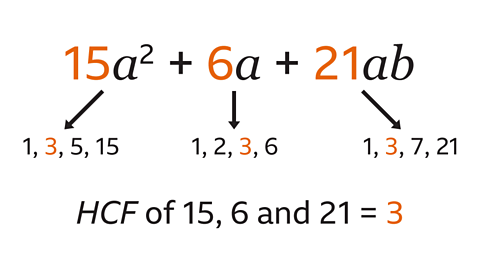
Essential knowledge for factorising includes understanding factors and highest common factor (HCF) The largest factor that will divide into the selected numbers. Eg, 10 is the highest common factor of 30 and 20. Highest common factor is written as HCF. (HCF), as well as having a good knowledge of divisibility rulesRecognising when a number can be divided exactly by a selected integer. Eg, any even number is divisible by 2 .
An expressionA mathematical sentence expressed either numerically or symbolically made up of one or more terms. that has been rewritten by taking out common factors has been factoriseTo express a number or an expression as the product of its factors. For example, the number 6 can be factorised as 2 √ó 3. 6ùíè ‚Äì 12 can be factorised as 6(ùíè ‚Äì 2)..
Factorising is the reverse process of expanding brackets.
A factorised expression is equivalentThe same as but in a different form. to the original expression. They are identity ≡An equation that is true no matter what values are chosen. The identity symbol ≡ links expressions that are identities.. The identity symbol (≡) is used to link the original expression and its equivalent factorised expression.
Understanding and using algebraic notation correctly is necessary to complete the factorising process properly.

Finding the highest common factors (HCF) in an expression
When the expressionA mathematical sentence expressed either numerically or symbolically made up of one or more terms. includes a constantA number or quantity that does not vary. A constant speed is a steady speed. Eg, the speed of light is constant. The speed of a car is not constant, it varies. the only highest common factor (HCF) will be a number:
- Find the HCF of the coefficientA number or symbol multiplied with a variable or an unknown quantity in an algebraic term. Eg, 5 is the coefficient of 5ùíè and constant, the greatest factor that is common to all the numbers in the expression.
- The HCF for the expression is a number.
When the expression has no constants:
- Find the HCF of the coefficients, the greatest factor that is common to all the coefficients in the expression.
- Find common variableA quantity that can take on a range of values. factors in each term, which may be a single variable or a combination of variables.
- The HCF of the expression is the productThe result of multiplying one number by another, eg the product of 4 and 5 is 20 since 4 √ó 5 = 20 of the number and variable HCFs.
Examples

Image caption, Find the highest common factor (HCF) of this expression.
Image caption, The expression includes a constant (12). The number 28 is a coefficient. The HCF of the expression will be a number. Find the HCF of the numbers 28 and 12
Image caption, To find the HCF of the expression, work out the factors of each number. The factors of 28 are 1, 2, 4, 7, 14 and 28. The factors of 12 are 1, 2, 3, 4, 6 and 12. The highest common factor of 28 and 12 is 4. The HCF of 28ùíÇ + 12 is 4
Image caption, Find the HCF of this expression.
Image caption, The expression has no constants. The HCF of the coefficients is the greatest factor that is common to all the numbers in the expression. No written coefficient means the coefficient is 1. The coefficients are 3, 5 and 1 (ùíÉ is 1ùíÉ). The factors of 3 are 1 and 3. The factors of 5 are 1 and 5. The factors of 1 (ùíÉ is 1ùíÉ) is 1. The HCF of 3ùíÇ + 5ùíÇùíÉ + ùíÉ is 1
Image caption, There are no common variable factors. 3ùíÇ, 5ùíÇùíÉ and ùíÉ do not have a variable that is common to all of them. The variable ùíÇ is in two of the terms, not all three. The variable ùíÉ is in two of the terms, not all three. The HCF of this expression is 1
Image caption, Find the HCF of this expression.
Image caption, The expression has no constants. The HCF of the coefficients is the greatest factor that is common to all the numbers in the expression. The coefficients are 15, 6 and 21. The factors of 15 are 1, 3, 5 and 15. The factors of 6 are 1, 2, 3 and 6. The factors of 21 are 1, 3, 7 and 21. The HCF of 15, 6 and 21 is 3
Image caption, The common variable in 15ùíǬ≤ + 6ùíÇ + 21ùíÇùíÉ is ùíÇ. The variable HCF is ùíÇ
Image caption, The HCF of the expression is the number HCF (3) multiplied by the variable HCF (ùíÇ). 3 √ó ùíÇ = 3ùíÇ. The HCF of the expression is 3ùíÇ
1 of 10
Question
Find the highest common factor of this expression.
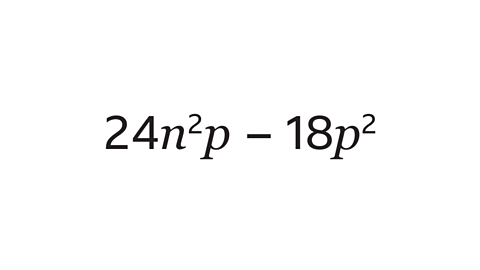
The expression has no constants.
The HCF of the coefficients is the greatest factor that is common to all the numbers in the expression.
- The coefficients are 24 and 18
- The HCF of 24 and 18 is 6
The common variable in 24\(n\)²\(p\) – 18\(p\)² is \(p\)
- The variable HCF is \(p\)
The HCF of the expression is the product of the number HCF (6) and the variable HCF (\(p\)).
- 6 √ó \(p\) = 6\(p\)
The HCF of the expression is 6\(p\)

Factorise simple expressions
- When the expression includes a constant the highest common factor (HCF) is a number.
- When the expression does not include a constant the HCF is a number, a variable or a combination of a number and variables.
To factorise an expression:
Find the HCF of the numbers in the expression.
Find the HCF of the variables in the expression.
Find the product of the number and variable HCFs and write this term in front of the bracket.
Work out the terms in the bracket by completing the factor pair for each of the original terms in the expression.
The identity symbol (≡) is used to link the original expression and its equivalent factorised expression.
Examples
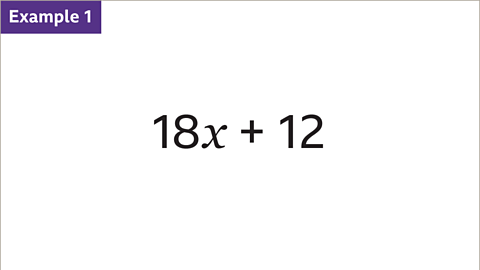
Image caption, Factorise 18ùíô + 12
Image caption, The expression includes a constant (12). The HCF is a number. The factors of 18 are 1, 2, 3, 6, 9 and 18. The factors of 12 are 1, 2, 3, 4, 6 and 12. The highest common factor of 18 and 12 is 6. The HCF 6 is written in front of the bracket.
Image caption, The first term in the bracket is 3ùíô because the factor pair for 18ùíô is 6 √ó 3ùíô. The second term in the bracket is 2 because the factor pair for 12 is 6 √ó 2. 18ùíô +12 is factorised as the equivalent expression 6(3ùíô+2).
Image caption, Factorise 12ùíÇùíÉ ‚Äì 3ùíÇ
Image caption, The highest common factor of 12 and 3 is 3. The HCF of the variable terms ùíÇùíÉ and ùíÇ is ùíÇ. The HCF of 12ùíÇùíÉ and 3ùíÇ is the product of 3 and ùíÇ (3ùíÇ).
Image caption, 3ùíÇ is the HCF of 12ùíÇùíÉ and 3ùíÇ. 3 is the highest common factor of 12 and 3. ùíÇ is the highest common factor of ùíÇùíÉ and ùíÇ. 3ùíÇ is written in front of the bracket. The first term in the bracket is 4ùíÉ because 3ùíÇ √ó 4ùíÉ = 12ùíÇùíÉ. The second term in the bracket is -1 because 3ùíÇ √ó -1 = -3. 12ùíÇùíÉ-3ùíÇ is factorised as the equivalent expression 3ùíÇ(4ùíÉ-1).
Image caption, Factorise the expression.
Image caption, The highest common factor of 6 and 12 is 6. Remember that ùíô¬≤ is the same as ùíô multiplied by ùíô. The HCF of the variable terms ùíô¬≤ùíö and ùíôùíö is ùíôùíö. The HCF of 6ùíô¬≤ùíö and 12ùíôùíö is 6ùíôùíö
Image caption, The HCF of 6ùíô¬≤ùíö and 12ùíôùíö is 6ùíôùíö. 6ùíôùíö is written in front of the bracket. The first term in the bracket is ùíô because 6ùíô¬≤ùíö is 6ùíôùíö √ó ùíô. The second term in the bracket is 2 because 12ùíôùíö is 6ùíôùíö √ó 2. 6ùíô¬≤ùíö + 12ùíôùíö factorises to the equivalent expression 6ùíôùíö(ùíô + 2).
1 of 9
Question
Factorise the expression.

- The highest common factor of 30 and 45 is 15
- The HCF of the variable terms \(m\)²\(n\) and \(mn\)² is \(mn\)
- The HCF of 30\(m\)²\(n\) and 45\(mn\)² is 15\(mn\)
- 15\(mn\) is the term in front of the bracket.
- The first term in the bracket is 2\(m\) because the factor pair for 30\(m\)²\(n\) is 15\(mn\) × 2\(m\)
- The second term in the bracket is 3\(n\) because the factor pair for 45\(mn\)² is 15\(mn\) × 3\(n\)
- 30\(m\)²\(n\) + 45\(mn\)² factorises to the equivalent expression 15\(mn\)(2\(m\) + 3\(n\)).
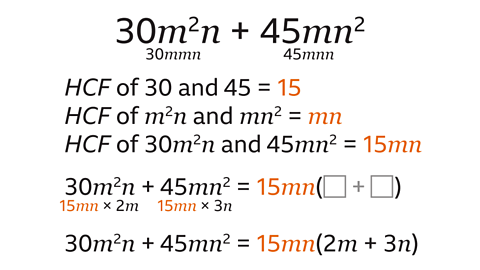
Practise rewriting expressions
Quiz
Practise rewriting expressions by taking out common factors with this quiz. You may need a pen and paper to help you with your answers.
Game - Divided Islands
Play the Divided Islands game! gamePlay the Divided Islands game!
Using your maths skills, help to build bridges and bring light back to the islands in this free game from ±´”„tv Bitesize.

More on Expressions and formulae
Find out more by working through a topic
- count7 of 8
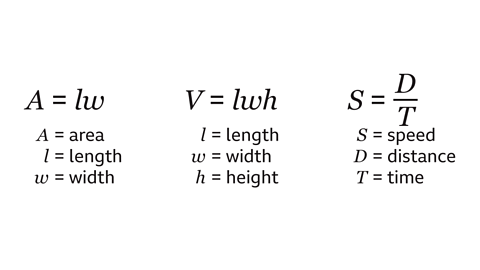
- count8 of 8
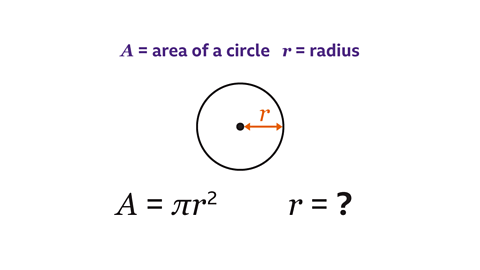
- count1 of 8
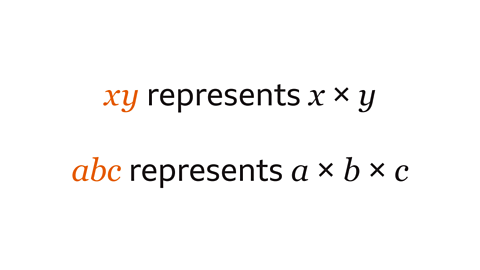
- count2 of 8
